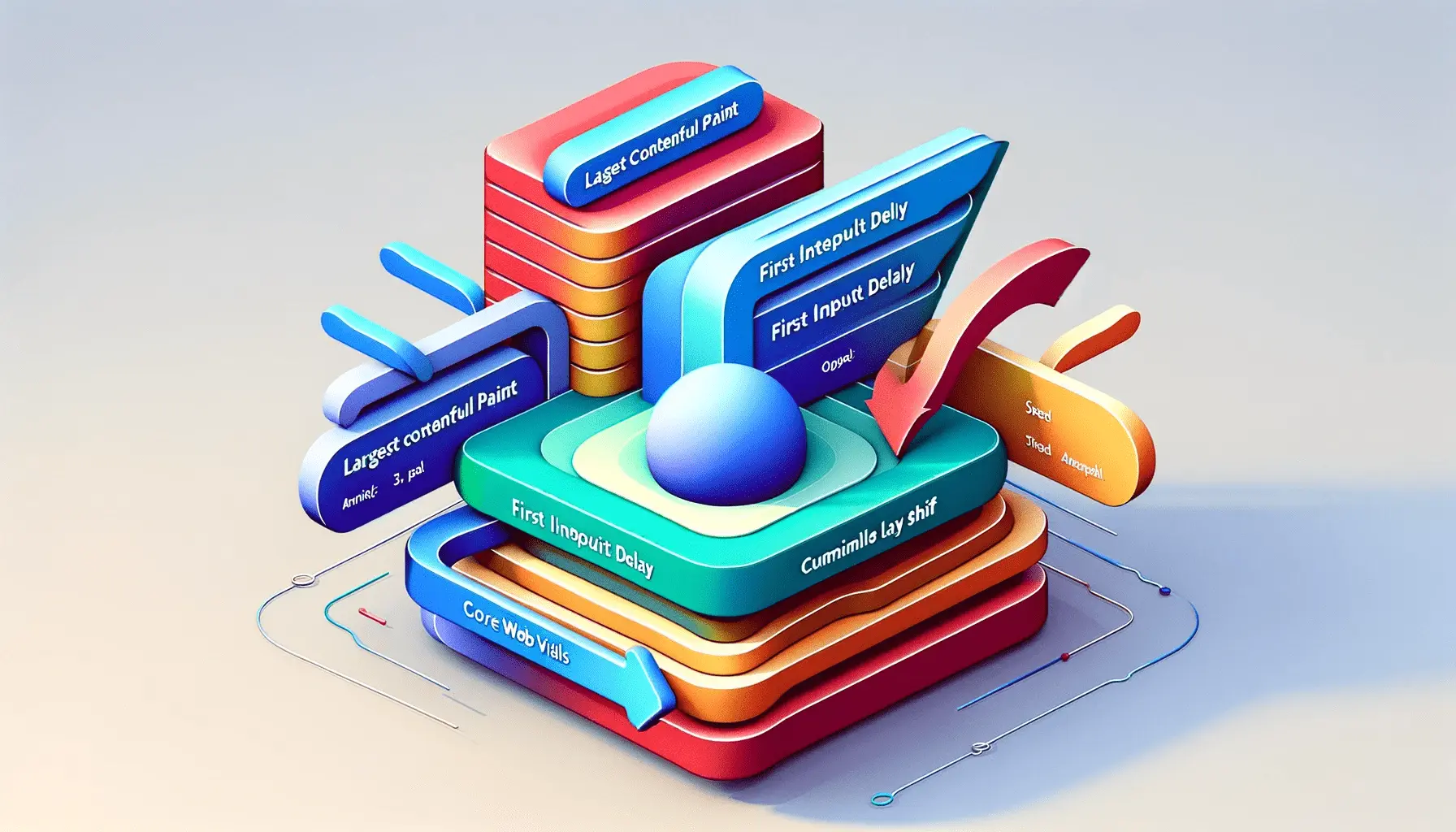Welcome to the comprehensive guide on Core Web Vitals, the latest buzz in the SEO world.
As search engines evolve, so do the metrics that gauge website performance and user experience.
Core Web Vitals have emerged as critical factors in understanding and optimizing websites for better search engine rankings and user engagement.
In this article, we delve deep into the intricacies of Core Web Vitals, exploring their significance, components, and impact on SEO strategies.
Our journey through these vital metrics will equip you with the knowledge to enhance your website’s performance in alignment with the latest SEO trends.
- Introduction to Core Web Vitals
- Optimizing Core Web Vitals for SEO
- Impact of Core Web Vitals on User Experience
- Core Web Vitals and Mobile Optimization
- Core Web Vitals and E-commerce Success
- Advanced Techniques for Core Web Vitals Optimization
- Monitoring and Maintaining Core Web Vitals
- Conclusion: The Integral Role of Core Web Vitals in SEO and User Experience
- Core Web Vitals: Essential FAQs
Introduction to Core Web Vitals
Core Web Vitals are a set of specific factors that Google considers important in a webpage’s overall user experience.
These metrics are part of Google’s “Page Experience” signals used in ranking websites.
Understanding and optimizing these vitals is crucial for anyone looking to improve their website’s performance in search engine results.
The three Core Web Vitals are Largest Contentful Paint (LCP), First Input Delay (FID), and Cumulative Layout Shift (CLS).
Each of these metrics provides a unique insight into different aspects of user experience, focusing on loading performance, interactivity, and visual stability.
Largest Contentful Paint (LCP)
LCP measures the loading performance of a page.
It marks the point in the page load timeline when the main content has likely loaded.
A fast LCP helps reassure the user that the page is useful.
For a good user experience, LCP should occur within 2.5 seconds of when the page first starts loading.
Improving LCP can involve optimizing server response times, reducing CSS blocking time, and optimizing images and other media on your site.
These steps ensure that the largest content elements on your page load swiftly, enhancing the user’s perception of speed.
First Input Delay (FID)
FID measures the time from when a user first interacts with your site to the time when the browser is able to respond to that interaction.
This metric is crucial for understanding the interactivity and responsiveness of your site.
To provide a good user experience, pages should have an FID of less than 100 milliseconds.
Optimizing for FID involves minimizing (or deferring) JavaScript, removing any non-critical third-party scripts, and using a web worker.
This ensures that the browser can quickly respond to user inputs, making the site feel more responsive and interactive.
Cumulative Layout Shift (CLS)
CLS measures the visual stability of your website.
It quantifies the amount of unexpected layout shift of visible page content.
A low CLS ensures that the page is stable as it loads, preventing elements from shifting around unexpectedly.
For a good user experience, strive to maintain a CLS of less than 0.1.
To improve CLS, ensure images and embeds have dimensions, minimize ad shifts, and avoid inserting new content above existing content unless in response to a user’s action.
This enhances the visual stability of your site, contributing to a more pleasant browsing experience.
Core Web Vitals are essential for providing a good user experience and are increasingly important for SEO. Optimizing these metrics can lead to better search rankings and improved user engagement.
Optimizing Core Web Vitals for SEO
Optimizing Core Web Vitals is not just about enhancing user experience; it’s also a critical component of SEO strategy.
Search engines, particularly Google, have started using these metrics as ranking factors.
Let’s explore how to optimize each of these vitals effectively.
Strategies for Improving Largest Contentful Paint (LCP)
- Optimize Server Response Time: Use a reliable hosting solution, leverage caching, and optimize your server configuration to improve response times.
- Optimize Images: Compress images without losing quality and use modern formats like WebP for faster loading.
- Minimize CSS and JavaScript: Remove unnecessary code, minify CSS and JavaScript files, and defer non-critical scripts to reduce load time.
Enhancing First Input Delay (FID)
- Minimize JavaScript Execution: Break up long tasks, defer unused JavaScript, and minimize the impact of third-party scripts.
- Use Browser Caching: Leverage browser caching to store resources locally, reducing load times on subsequent visits.
- Optimize for Mobile: Ensure that your website is responsive and mobile-friendly, as mobile users often experience higher FID.
Reducing Cumulative Layout Shift (CLS)
- Specify Image and Video Dimensions: Always include width and height attributes to prevent layout shifts during loading.
- Avoid Injecting Content Above Existing Content: Dynamically injected content can cause shifts, so avoid it unless triggered by user interaction.
- Load Ads and Embeds Responsibly: Ensure that ads and embeds have reserved space and don’t push content around when they load.
By focusing on these optimization strategies, you can significantly improve your website’s Core Web Vitals scores.
This not only enhances the user experience but also aligns your website with SEO best practices, potentially improving your search engine rankings.
Remember, optimizing for Core Web Vitals is an ongoing process. Regular monitoring and adjustments are key to maintaining optimal website performance and SEO rankings.
Impact of Core Web Vitals on User Experience
Core Web Vitals are more than just SEO metrics; they are fundamental indicators of a website’s user experience (UX).
A positive UX is crucial for retaining visitors and converting them into customers or followers.
Let’s examine how each Core Web Vital impacts UX.
Largest Contentful Paint (LCP) and User Engagement
LCP directly influences a visitor’s first impression of your site.
A fast LCP can:
- Reduce bounce rates as users are less likely to leave a slow-loading site.
- Encourage deeper engagement with the content, as users perceive the site to be responsive and efficient.
First Input Delay (FID) and Interactivity
FID is critical for sites that rely on user interaction, such as e-commerce platforms and online services.
A low FID ensures:
- Improved user satisfaction as the site responds quickly to their interactions.
- Better conversion rates, as users are more likely to complete actions without frustration.
Cumulative Layout Shift (CLS) and Visual Stability
CLS affects how users perceive the stability of your site.
A low CLS provides:
- A smoother reading and browsing experience, free from annoying shifts and jumps.
- Increased trust in the site, as it appears more professional and well-maintained.
Enhancing these Core Web Vitals leads to a more enjoyable and efficient experience for users, which is essential for building a loyal audience and customer base.
In the digital age, where user attention spans are short, providing a seamless UX is a key differentiator.
User experience is not just a part of SEO; it’s the heart of a successful online presence. Prioritizing Core Web Vitals is prioritizing your users.
Core Web Vitals and Mobile Optimization
In today’s mobile-first world, optimizing Core Web Vitals for mobile devices is crucial.
Mobile users expect quick, responsive, and stable experiences, just like on desktops.
Let’s explore how Core Web Vitals play a pivotal role in mobile optimization.
Mobile-Specific Challenges in LCP
Mobile devices often have slower network speeds and less processing power, impacting LCP.
To optimize LCP for mobile:
- Implement responsive images: Use different image sizes for different screen resolutions and connections.
- Optimize server response times: Utilize a Content Delivery Network (CDN) to reduce latency.
Improving FID on Mobile Devices
Mobile users frequently interact with websites through taps and swipes, making FID crucial.
To enhance FID on mobile:
- Minimize JavaScript execution: Simplify scripts and use asynchronous loading to reduce delay.
- Optimize touch event handlers: Ensure that touch interactions are responsive and efficient.
Addressing CLS in Mobile Browsing
Mobile screens are smaller, making layout shifts more disruptive.
To minimize CLS on mobile:
- Use fluid layouts: Ensure elements resize smoothly across different screen sizes.
- Avoid intrusive pop-ups and ads: These can cause significant layout shifts on mobile devices.
By focusing on these mobile-specific optimizations, you can significantly improve the Core Web Vitals scores for your mobile site.
This not only enhances the user experience for mobile visitors but also aligns with Google’s mobile-first indexing, potentially boosting your mobile search rankings.
Optimizing Core Web Vitals for mobile is not just a technical task; it’s about understanding and catering to the mobile user’s needs and behaviors.
Core Web Vitals and E-commerce Success
For e-commerce websites, Core Web Vitals are more than just metrics; they are key drivers of customer satisfaction and sales.
A seamless online shopping experience heavily relies on website performance.
Let’s delve into how optimizing these vitals can boost e-commerce success.
LCP: The First Impression Counts in Online Shopping
A fast LCP is crucial for e-commerce sites to keep potential customers engaged from the moment they land on the page.
To optimize LCP:
- Compress and optimize product images without sacrificing quality.
- Utilize lazy loading for images and videos to speed up initial page load times.
FID: Smooth Interactions Lead to Better Conversions
In e-commerce, every millisecond counts in user interaction.
Enhancing FID involves:
- Optimizing JavaScript and CSS that block interactivity.
- Ensuring quick and responsive feedback on user inputs, like clicks on product categories.
CLS: Stability Enhances Shopping Experience
Unexpected layout shifts can disrupt the shopping process, leading to frustration.
To reduce CLS:
- Ensure stable loading of product images and descriptions.
- Avoid sudden changes in layout during user interaction, especially in the checkout process.
By focusing on these Core Web Vitals, e-commerce sites can offer a more pleasant and efficient shopping experience, leading to higher customer satisfaction, increased time on site, and ultimately, better conversion rates.
In the competitive world of e-commerce, optimizing Core Web Vitals can be the difference between a sale and an abandoned cart.
Advanced Techniques for Core Web Vitals Optimization
Beyond the basics, there are advanced techniques that can further enhance Core Web Vitals scores.
These methods require a deeper understanding of web technologies but can significantly impact your site’s performance and user experience.
Implementing Critical CSS
Critical CSS involves identifying and loading only the essential styles needed for the above-the-fold content.
This technique can:
- Significantly reduce the time to first paint and LCP.
- Improve FID by reducing the amount of CSS the browser needs to process before it becomes interactive.
Utilizing Web Workers for JavaScript Execution
Web workers allow JavaScript to run in the background, separate from the main execution thread.
This can:
- Improve FID by offloading complex calculations and data processing.
- Enhance the overall responsiveness of the page.
Optimizing Fonts and Text Rendering
Custom fonts can significantly impact CLS and LCP.
To optimize fonts:
- Use font-display swap to minimize the impact on text visibility during font loading.
- Preload key fonts to ensure they are available early in the page load process.
These advanced techniques require careful implementation and testing but can lead to substantial improvements in Core Web Vitals.
They demonstrate a commitment to delivering the best possible experience to your users.
Advanced optimization of Core Web Vitals is a journey towards technical excellence, enhancing not just the performance metrics but also the overall quality of your website.
Monitoring and Maintaining Core Web Vitals
Optimizing Core Web Vitals is an ongoing process.
Regular monitoring and maintenance are essential to ensure that your website continues to meet these performance standards over time.
Let’s explore the best practices for monitoring and maintaining Core Web Vitals.
Using Tools for Continuous Monitoring
Several tools can help you monitor Core Web Vitals effectively:
- Google Search Console: Provides a report on Core Web Vitals, highlighting issues across your entire site.
- PageSpeed Insights: Offers both lab and field data on your web pages, giving insights into areas for improvement.
- Chrome User Experience Report: Offers real-world user experience data for your website.
Regular Audits and Updates
Conducting regular audits of your website can help identify new opportunities for improvement.
This includes:
- Assessing the impact of new content or design changes on Core Web Vitals.
- Updating your website in response to new technologies and web standards.
Responding to User Feedback
User feedback can provide valuable insights into real-world experiences on your site.
Pay attention to:
- User complaints about loading times, interactivity, or layout shifts.
- Feedback from user surveys or usability tests.
By continuously monitoring and maintaining your Core Web Vitals, you can ensure that your website not only performs well in search rankings but also provides an excellent user experience.
This proactive approach is key to staying ahead in the ever-evolving digital landscape.
Remember, Core Web Vitals are not set-and-forget metrics. They require ongoing attention and adaptation to keep your site performing at its best.
Conclusion: The Integral Role of Core Web Vitals in SEO and User Experience
In the dynamic landscape of SEO, Core Web Vitals have emerged as pivotal elements in shaping a website’s success.
These metrics are not mere numbers; they are reflections of a user’s journey through your site, influencing both their experience and your site’s search engine performance.
As we’ve explored, understanding and optimizing Core Web Vitals is crucial for any website aiming to thrive in the competitive digital arena.
Summarizing the Impact of Core Web Vitals
Core Web Vitals, encompassing LCP, FID, and CLS, serve as the cornerstones of a robust SEO strategy.
They are the benchmarks for a website’s health, directly impacting user satisfaction and search engine rankings.
A quick recapitulation of their significance reveals:
- LCP’s role in forming first impressions through speedy content loading.
- FID’s importance in ensuring smooth and responsive user interactions.
- CLS’s contribution to maintaining visual stability and preventing disruptive layout shifts.
Embracing the Continuous Evolution
Optimizing for Core Web Vitals is not a one-time task but a continuous journey.
As user expectations evolve and search algorithms become more sophisticated, staying updated with these metrics is imperative.
Regular monitoring, user feedback incorporation, and adapting to technological advancements are key to maintaining optimal performance.
In conclusion, Core Web Vitals are more than just components of SEO; they are the essence of a quality user experience.
By prioritizing these metrics, you not only enhance your website’s search engine visibility but also build a foundation for lasting user satisfaction and loyalty.
In the realm of digital marketing, Core Web Vitals stand as crucial pillars supporting the bridge between user needs and business goals.
Want your website to top Google search rankings? Leave the SEO to our professional agency!
Core Web Vitals: Essential FAQs
Understanding Core Web Vitals is crucial for SEO and user experience. Here are some frequently asked questions to deepen your knowledge.
Core Web Vitals are a set of metrics by Google, focusing on loading performance (LCP), interactivity (FID), and visual stability (CLS).
Core Web Vitals directly impact SEO by influencing a website’s ranking on search engine results pages, based on user experience.
Yes, optimizing Core Web Vitals enhances user engagement by improving site speed, responsiveness, and visual stability.
LCP measures the time taken for the main content of a page to load, indicating loading performance.
FID assesses the time from user interaction to browser response, crucial for site interactivity.
CLS quantifies the amount of unexpected layout shift of visual page content, impacting visual stability.
Core Web Vitals should be monitored regularly to ensure ongoing website performance and user experience optimization.
Yes, Core Web Vitals are especially relevant for mobile SEO due to the growing importance of mobile user experience.










